Castle Quarter
| Castle Quarter | |
| Welsh: Cwr y Castell | |
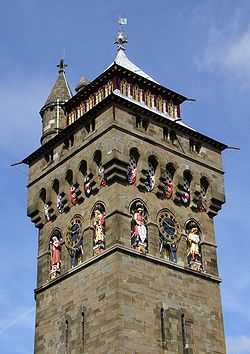 The Clock Tower of Cardiff Castle |
|
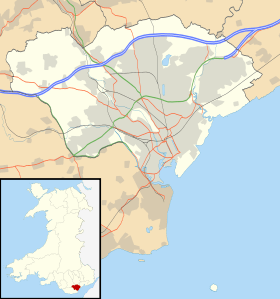 Castle Quarter |
|
| Principal area | Cardiff |
|---|---|
| Ceremonial county | Cardiff |
| Country | Wales |
| Sovereign state | United Kingdom |
| Post town | CARDIFF |
| Postcode district | CF10 |
| Dialling code | 029 |
| Police | South Wales |
| Fire | South Wales |
| Ambulance | Welsh |
| EU Parliament | Wales |
| UK Parliament | Cardiff Central |
| Welsh Assembly | Cardiff Central |
Coordinates: 51°28′48″N 3°10′30″W / 51.48°N 3.175°W
Castle Quarter (Welsh: Cwr y Castell) is a commercial area in the north of the city centre of Cardiff, Wales.
The Castle Quarter includes some of Cardiff's Victorian and Edwardian arcades: Castle Arcade, High Street Arcade and Duke Street Arcade, and principal shopping streets: St Mary Street, High Street, Castle Street and Duke Street.
Development of the area began in February 2010 and is expected to be completed by July 2011. Cardiff Council says that work to create the Castle Quarter as a pedestrian friendly environment for High Street and St Mary Street is designed to enhance the city centre.[1]
Development

Developments outside Cardiff Castle have linked the castle grounds and Bute Park directly to the city centre via a walkway with High Street, aiming to tie the leisure facilities with the business facilities. There are already signs that footfall is improving, according to Cardiff Council.[2]
Works temporarily ceased between 14 November 2010 and January 2011 for the Christmas period,[1] and are expected to be completed by July 2011.[3]
The development is part of the £30m Sustainable Travel City project jointly funded by Cardiff Council and the Welsh Assembly Government[4]
Construction works
The £4 million[5] project to change the street-scape of the city centre commenced in February 2010. Cardiff Council hope to provide an enhanced retail and pedestrian experience for residents, businesses and visitors to the city centre, to reduce traffic, air pollution and noise levels.[6]
Work to pedestrianise St Mary Street and High Street in the city centre began in June/July 2010. Roadworks which took place outside Castle Street have caused traffic problems for motorists and commuters using the busy vein through the city centre.[6] These roadworks ended on 31 October[7] The Council will now concentrate work between Quay Street and Wood Street in order to turn St Mary Street into an area of pedestrian priority.[8]
Guildhall Place will become one-way, with a taxi rank stationed on the north side. The lower end of Guildhall Place will be kept two-way to allow access to private car parks.[6]
Disruption
The roadworks stretching from Boulevard de Nantes to Castle Street have caused severe congestion on one of the main routes of travel through the city centre between east and west Cardiff.[3]
Business owners in the area's arcades are seeking compensation from Cardiff Council due to the disruption of the roadworks. The council has offered each business a £300 reduction on rates as the work is short term.[1]
History of the principal streets
Church Street
The original first floor of Truffles tea room was once the residence of John Wesley where he first began his preaching of Methodism.[9]
High Street
Riots took place during the 16th century between supporters of the rivalling Herberts family, who hailed from the Friary, and the Mathews family of Radyr. Herbert’s servants were all arrested in the course of their fighting and how he was able to free them all because his brother was the town sheriff. The street may have been as bustling with activity as much back then as it is today, albeit with a very different kind of activity. There would have been market stalls, but also stocks, whipping posts and there was even a jail house on this street.
At the top end of High Street, before Duke Street and the Castle, used to stand the old Guildhall, demolished in 1860 for the construction of the larger one standing today.[9]
Trinity Street
Trinity Street is the location of St John the Baptist Church, built over 800 years ago and has been renovated and resized over the centuries. Its tower was a gift from the Neville sisters, Anne and Isabel, in 1473 and has the most pinnacles of any church tower in Britain, except St Giles in Wrexham. Anne Neville was both Princess of Wales, after her marriage to Edward of Westminster, and later married Richard III to become Queen of England.
Inside the church, two male stone effigies lie side by side to mark the burial place of Sir John Herbert and his brother William, both famous in the area in the 16th and 17th centuries. Sir John, who lies on the right on a red cushion, was known to speak four languages, as he was the English Ambassador to France, Poland, Holland and Denmark and was Chief Secretary to both Elizabeth I and James I.[9]
Victorian and Edwardian arcades
| Name | Image | Year opened | Entrances | Notes |
|---|---|---|---|---|
| Central Market |  | 1891 | St. Mary Street Trinity Street | Central Market was designed by the county engineer William Harpur. 349 stalls were in the original layout. The market opened in 1891 and has entrances on St. Mary Street and Trinity Street [10] Central Market is a Grade II* Listed building.
The market consists of two shopping levels, a ground floor and a balcony level which wraps around the market exterior walls on the interior . There is a large H. Samuel clock above the High Street entrance , which was presumably donated by the H. Samuel jewellery chain, which once had a store just outside the High Street entrance. Traders in the market offer a variety of fresh produce, cooked food, various delicacies and more durable goods. A trader of note is Ashton's the fishmongers,[11] who have traded in the market since 1866 at the Trinity Street entrance selling a wide range of fresh seafood. |
| Castle Arcade |  | 1887 | Castle Street High Street | Castle Arcade opened in 1887 and is a Grade II* Listed building. The Castle arcade, as the name suggests, runs from opposite Cardiff Castle to High Street, north of St Mary St. The arcade hasa variety of small boutique shops as well as cafes and delicatessens, and fair-trade and organic shops.[12]
One of the longer of Cardiff's famous Victorian arcades, Castle Arcade is home to a variety of shops selling, among other things, crystals, air pistols, fancy dress, books and clothes. There are several shops on the gallery level.[13]
|
| Duke Street Arcade |  | 1902 | Duke Street High Street Arcade | Duke Street Arcade opened in 1902 is a Grade II Listed building. Duke Street Arcade joins High Street arcade, and is just opposite Cardiff Castle. Duke Street Arcade is lined with stores including hairdressers, bridal shops and Welsh gift shops.[12] |
| High Street Arcade |  | 1885 | High Street St John Street | High Street Arcade opened in 1886 and is a Grade II Listed building. It has entrances on High Street and St John Street. High Street arcadeis known for its range fashion stores which include designer clothes, individual fashions, jewellery and vintage clothes. One will also find children's clothes and toys, gifts and a New York Deli in the arcade.[12] |
Significant buildings and parks
Cardiff Castle
Cardiff Castle (Welsh: Castell Caerdydd) forms the centrepoint of the Castle Quarter on Castle Street. It is a medieval castle and Victorian architecture Gothic revival mansion, transformed from a Norman keep erected over a Roman fort.
The Norman keep was built on a high motte on the site of a Roman castra, first uncovered during the third Marquess of Bute's building campaign. The Norman keep, of which the shell remains, was constructed about 1091 by Robert Fitzhamon, lord of Gloucester and conqueror of Glamorgan.[14]
In the early 19th century the castle was enlarged and refashioned in an early Gothic Revival style for John Crichton-Stuart, 2nd Marquess of Bute by Henry Holland. But its transformation began in 1868 when John Crichton-Stuart, 3rd Marquess of Bute commissioned William Burges to undertake a massive rebuilding which turned the castle into a 19th century fantasy of a medieval palace, with a series of rooms that, perhaps, constitute the highest achievement of later Victorian Gothic Revival design.

Bute Park
Bute Park is an extensive area of mature parkland accessible from Castle Street. Flanked by the River Taff, Sophia Gardens, Pontcanna Fields and Cardiff Castle, Bute Park is a popular 'green lung' of historic and wildlife interest. The Taff Trail can be accessed at the northern end of Blackweir Fields. A Cardiff Waterbus stop is located adjacent to Canton Bridge at the southern end of the park offering trips to Cardiff Bay, Penarth and the barrage.
Animal Wall
The Animal Wall is a sculptured wall depicting 15 animals on Castle Street. It is a Grade I listed structure.[15]
Designed by William Burges in 1866, but it was not built until 1890, The work of the restoration of Cardiff Castle and the building of the Animal Wall for the Marquess of Bute, was continued by his former assistant William Frame.[16] The original nine animal figures were sculptured by Thomas Nicholls, they were the hyena, wolf, apes, seal, bear, lioness, lynx, and 2 different lions. They were painted in naturalistic colours, although since then the paint work on the sculptures has been removed.[17][18]
Central Market
Cardiff Central Market (Welsh: Marchnad Ganolog Caerdydd) is a Victorian indoor market on St Mary Street. The market was designed by the Borough Surveyor, William Harpur, and opened in May 1891.[19] A farmers' market is known to have existed at the site since the 18th century.
Cardiff Arms Park
Cardiff Arms Park (Welsh: Parc yr Arfau Caerdydd) is a rugby union stadium situated on Castle Street/Westgate Street. The first stands appeared for spectators in the ground in 1881–1882,[20] although the Arms Park had cricket played on the site since 1848.[21] Until the end of the 2008-09 season, the stadium was the home to both the Cardiff Blues rugby union team and Cardiff Rugby Football Club, however with the Blues moving out to the Cardiff City Stadium, Cardiff RFC are now the only tenants.
-
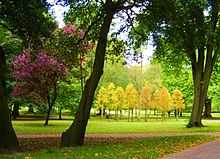
Bute Park
-
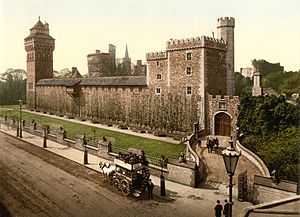
Animal Wall, c. 1890
-

St Mary Street entrance to Central Market
-
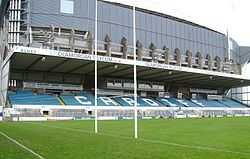
Cardiff Arms Park in the foreground
Events
The 2010 Christmas Market was located in the Castle Quarter. The market saw more than 40 stalls open up along High Street, St John's Street and Working Street.[22]
Transport
Local
Bus
As most of the area is pedestrianised, bus stops hubs are located on peripheral road, principally on Westgate Street (to the west of the quarter) and Kingsway (in the north-east of the quarter). They form part of an anti-clockwise "bus box" around the city centre. A map and list of services in the area, operated by Cardiff Bus can be found here
Cardiff central bus station is situated south of the area, next to Central railway station.
Waterbus
A Cardiff Waterbus stop is located in Bute Park, off Castle Street. Services run to Cardiff Bay and Penarth.
Cycle
Cardiff Council's chief traffic executive has said there will be designated cycle routes through new pedestrianised areas in the city centre.
Once the Castle Quarter has been completed, there will be designated pathways for disabled access next to the building line, and a separate pathway for cyclists on St Mary Street and High Street. Cyclists are permitted in most city centre areas including around St David's and The Hayes – but are restricted access to cycle down Queen Street.[23]
Buggy
Electric buggies designed to carry disabled and elderly passengers around the pedestrianised zones in the city centre operate in the Castle Quarter. The vehicles can hold up to three passengers and be flagged down anyway on the route. No ticket is needed and drivers only pick up the less mobile pedestrians. The buggies travel on a route which weaves through the pedestrianised areas of the city centre, include St Mary Street, Queen Street, Central Market and St. David's Hall.[24]
The initial three-month trial ran from October to December 2010, during which 3,380 people were carried, and cost £40,000. This period has been extended to March 2011, due to the service's popularity, funded with a further £25,000 under the Cardiff Council and Welsh Assembly Government Sustainable Travel City initiative. The service is available 09:30 - 17:30 Monday to Friday.[25]
National
Rail
Castle Quarter is located 0.4-mile (0.64 km) from Cardiff Central railway station for local and mainline services.
Road
The A4161 is the main road in the Castle Quarter, formed by Castle Street, Duke Street and Kingsway. It connects to the A48 at Ely Bridge, leading to J33 of the M4 motorway, and Llanedeyrn, leading to J29A and J30. The A470 can be joined at Kingsway, leading to M4 J32.
References
- ↑ 1.0 1.1 1.2 BBC News | Cardiff shops seek compensation for roadworks
- ↑ Guardian Cardiff | Cardiff Council takes on illegal parking
- ↑ 3.0 3.1 Guardian Cardiff | Opinion: Another day of gridlock, but can we look beyond the roadworks?
- ↑ Wales Online | Castle street to close in final push for crossing scheme
- ↑ Guardian Cardiff | Wonderful Copenhagen - a glimpse of Cardiff's future
- ↑ 6.0 6.1 6.2 Guardian Cardiff | City centre roadworks into next phase
- ↑ Guardian Cardiff | Castle Street roadworks end as figures suggest change in travel behaviour
- ↑ Cardiff Council | High Street - The Future
- ↑ 9.0 9.1 9.2 WalesOnline | Cardiff city centre history
- ↑ "Late 1800s". Cardiff Market. Retrieved 2008-07-03.
- ↑ Cardiff, Central Market, Ashton's Fish Stall:: OS grid ST1876 :: Geograph Britain and Ireland - photograph every grid square!
- ↑ 12.0 12.1 12.2 Why Cardiff Quaint Arcades
- ↑ Stay in Wales Castle Arcade
- ↑ Brewer's Britain & Ireland (2005), s.v. "Cardiff"; John Davies, Cardiff and the Marquesses of Bute.
- ↑ Animal Wall-Grade I Listed
- ↑ Cardiff Castle timeline
- ↑ Cardiff Castle's animal wall under repair
- ↑ Do you nose how castle sculpture used to look?
- ↑ "Cardiff: the building of a capital". Glamorgan Record Office. Retrieved 2008-09-17.
- ↑ "Red Dragon" (1912). Reminiscences of the Cardiff Rugby Football Club, "Opening ceremony of the new stands, Cardiff Arms Park", 5 October 1912. Cardiff Rugby Football Club.
- ↑ "Cardiff Arms Park, A short History - The Creation of the Arms Park". Glamorgan County Cricket Club & CricketArchive. Retrieved 21 May 2008.
- ↑ Guardian Cardiff | Lights on: Christmas comes to Cardiff
- ↑ Guardian Cardiff | Cyclists to share pedestrianised areas in new city centre Castle Quarter
- ↑ Guardian Cardiff | New city centre electric buggies launch
- ↑ WalesOnline | Buggies trial wins extra time
External links
| ||||||||||||||||||||||||||||||||||||||||